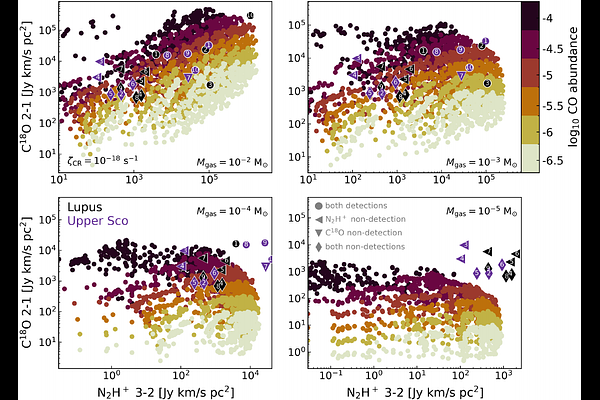The ALMA Survey of Gas Evolution of PROtoplanetary Disks (AGE-PRO): V. Protoplanetary gas disk masses

The ALMA Survey of Gas Evolution of PROtoplanetary Disks (AGE-PRO): V. Protoplanetary gas disk masses
Leon Trapman, Ke Zhang, Giovanni P. Rosotti, Paola Pinilla, Benoît Tabone, Ilaria Pascucci, Carolina Agurto-Gangas, Rossella Anania, John Carpenter, Lucas A. Cieza, Dingshan Deng, Camilo González-Ruilova, Michiel R. Hogerheijde, Nicolás T. Kurtovic, Aleksandra Kuznetsova, James Miley, Laura M. Pérez, Dary A. Ruíz-Rodríguez, Kamber Schwarz, Anibal Sierra, Estephani TorresVillanueva, Miguel Vioque
AbstractThe evolution of the gas mass of planet-forming disks around young stars is crucial for our understanding of planet formation, yet it has proven hard to constrain observationally, due both to the difficulties of measuring gas masses and the lack of a homogeneous sample. Here we present a large grid of thermochemical models which we use to measure protoplanetary gas disk masses of AGE-PRO, the ALMA survey of Gas Evolution in PROtoplanetary disks. AGE-PRO covers a sample of 30 disks around similar spectral type (M3-K6) stars with ages between 0.1 and 10 Myr. Our approach is to simultaneously fit observations of CO isotopologues and N2H+, a complementary molecule produced when CO freezes out. We find that the median gas mass of the three regions decreases over time, from 7.0(+4.4,-2.6)x10^-3 Msun in Ophiuchus (<1 Myr) to 9.4(+5.4,-3.4)x10^-4 Msun for Lupus (~1-3 Myr) and 6.8(+5.1,-2.8)x10^-4 Msun for Upper Sco (~2-6 Myr), with ~1 dex scatter in gas mass in each region. We note that the gas mass distributions for Lupus and Upper Sco look very similar, which could be due to survivorship bias for the latter. The median bulk CO abundance in the CO emitting layer is found to be a factor ~10 lower than the ISM value but does not significantly change between Lupus and Upper Sco. From Lupus to Upper Sco the median gas-to-dust mass ratio increases by a factor ~3 from ~40 to ~120, suggesting efficient inward pebble drift and/or the formation of planetesimals.